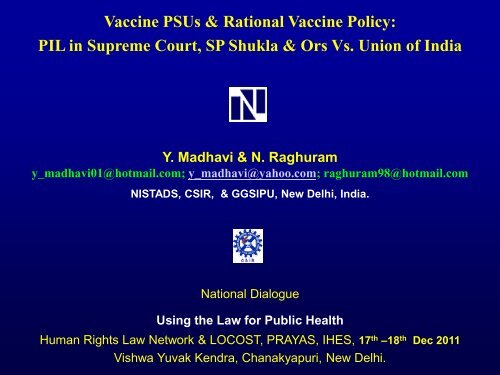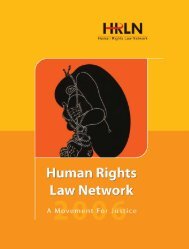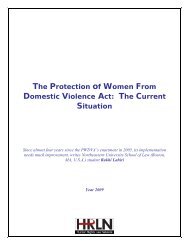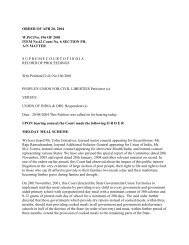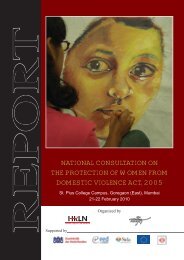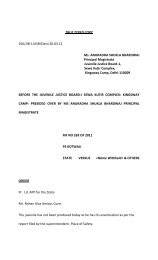You also want an ePaper? Increase the reach of your titles
YUMPU automatically turns print PDFs into web optimized ePapers that Google loves.
Vaccine PSUs & Rational Vaccine Policy:<br />
PIL in Supreme Court, SP Shukla & Ors Vs. Union of India<br />
Y. Madhavi & N. Raghuram<br />
y_madhavi01@hotmail.com; y_madhavi@yahoo.com; raghuram98@hotmail.com<br />
NISTADS, CSIR, & GGSIPU, New Delhi, India.<br />
National Dialogue<br />
Using the <strong>Law</strong> for Public Health<br />
<strong>Human</strong> <strong>Rights</strong> <strong>Law</strong> <strong>Network</strong> & LOCOST, PRAYAS, IHES, 17 th –18 th Dec 2011<br />
Vishwa Yuvak Kendra, Chanakyapuri, New Delhi.
Indian Vaccine Scenario at a glance<br />
‣Vaccines are important preventive medicine in Primary Health Care<br />
‣National health security is closely linked to self-reliance in vaccines & drugs<br />
‣Unlike curative drugs, vaccines are given to all – hence need stronger economic logic<br />
‣Vaccines constitute 2% of entire global pharmaceutical industry:growth drivers<br />
‣World vaccine market ($22 billion) dominated by Sanofi, GSK, Merck & Wyeth<br />
‣Indian vaccine market is huge: $ 2 billion growing at 22% per year<br />
‣India is among the largest vaccine makers and buyers globally<br />
‣6 Primary vaccines are under GOI‟s EPI (TT, DT, DPT, BCG, OPV, Measles)<br />
‣Present cost of all EPI vaccines/child is Rs.30/- or Rs.750 m for 25 m newborns/pa<br />
‣Liberalization, globalization & aid politics are expanding our vaccine markets<br />
‣Many expensive new & combination vaccines are flooding the market (hep, flu etc)<br />
‣Vaccine efficacy, cost-benefit/risk-benefit are relevant only when need is proven<br />
‣Once this logic is skipped to allow one vaccine, every other vaccine would follow<br />
‣Ethics of childhood vaccination: „coverage‟ more important than protection<br />
‣Taking all vaccines in India needs 27 doctor visits and Rs. 30,000/- per child
The complexities of vaccine decisions<br />
‣ Disease surveillance, pathogen variations in countries/populations<br />
‣ Incidence levels of each disease that qualify for mass vaccination<br />
‣ Efficacy, safety and affordability of the vaccine in the target population<br />
‣ Rigorous cost-benefit analyses for each (new) vaccine<br />
‣ Choice between indigenous development and/or procurement of vaccines<br />
‣ The role of public vs. private sector in vaccine R&D, production<br />
‣ Choice of technologies, their access and affordability<br />
‣ Individual vs. Combination vaccines (cocktails or multivalent?)<br />
‣ Choice of selective vs. universal vaccination<br />
‣ National priorities vs. international obligations<br />
‣ Personnel, logistics and resource mobilisation
Origins of the Indian Vaccine System<br />
‣ Indian vaccine research & production system has a history of over a century<br />
‣ Modern medical research in India began with vaccines<br />
‣ India was an early bird in vaccines; a world leader in plague vaccine<br />
‣ Fair institutionalisation of vaccine R&D and production under the British<br />
‣ Indian govt. took lead to encourage indigenous vaccine development<br />
‣ Availed international support as a member country of WHO since 1948<br />
‣ Govt‟s official policy favoured self reliance & self sufficiency till 2005
Innovative Indian Vaccine Public Sector Institutions<br />
Source: Y. Madhavi, Plos Med, 2005
No of Vaccine Institutions closed down<br />
Vaccine Institute Year Vaccine/sera produced<br />
1. Bengal Chemicals & Pharmaceuticals Ltd, Calcutta. 1901 Vaccines, sera, chemicals, synthetics & dyes (closed in 2000, being revived)<br />
2. Vaccine Institute, Nagpur (became PSU in 1980 ) 1900 Smallpox, cholera (closed in 2000s)<br />
3. West Bengal lab Calcutta (became PSU in 1980 ) 1980 Vaccines, Sera, synthetic dyes (closed in 2000s)<br />
4. Bengal immunity Ltd. Calcutta 1919 TT, DT, DTP, cholera, typhoid, rabies, anti-venums (closed in 2003)<br />
5. Smithstrain street Lab, Chennai (PSU in 1977) 1821 Vaccines and Sera (closed in 2000s)<br />
6. Pasteur Institute of India, Kasauli 1900 Anti-Rabies (Closed)<br />
7. The Pasteur Medical Institute, Shillong, Assam 1917 Typhid, cholera, anti-rabies treatment (closed down in 2006)<br />
8. Vaccine Lymph Department, Belgaum 1904 Vaccine Lymph (closed in 1980s)<br />
9. Vaccine lymph Department, Calcutta 1890s Vaccine lymph (closed in 1980s)<br />
10. Cholera vcacne Lab, Calcutta 1890s Cholera (closed down in 1980s)<br />
11. Pasteur Institute, Calcutta 1910 Anti-rabies (closed in 1980s)<br />
12. The Bengal Public Health Lab, Calcutta 1900s Cholera (stopped production in mid 1980s) converted as sterility testing lab<br />
13. The Provincial Hygiene Institute, Lucknow 1900s Cholera (closed in mid 2000s)<br />
14. State Vaccine Institute, Patwada Nagar 1903 Vaccine Lymph, anti-rabies (closed in 2003)<br />
15.The Vaccine Institute, Ranchi 1900 Vaccine Lymph, Cholera, anti-rabies, (closed in 2000s)<br />
16. The School of Tropical Medicine, Calcutta 1921 (No vaccine production since 1980s ) Epidemiological, diagnostic services<br />
17. Institute of Preventive Medicine, Hyderabad 1870 Plague, Smallpox, Anti-rabies, TT (closed in 2005)<br />
18. Vaccine Institute Vadodara 1973 Anti rabies (closed in 2007)<br />
19. Public Health laboratory, Tiruvanthapuram 1937 Anti-rabies (no more vaccine production) Serves as immunology lab<br />
20. Public Health Laboratory, Patna 1900 Cholera (closed in 2007)<br />
21. Public Health laboratory, Bangalore 1900 Cholera (closed)<br />
22. Indian Vaccine Corporation Ltd. Gurgaon 1989 Closed in 1992<br />
23. King Institute of Prventive Medicine, Chennai 1898 Vaccine Lymph, TT, Typhoid, Cholera, (Production suspended in 2005)<br />
24. Central Research Institute , Kasauli 1905 Typhoid, cholera anti-rabies, anti-snake venum (closed in Jan 2008)<br />
25. BCG vaccine Lab, , Chennai 1946 BCG vaccine (suspended in 2008)<br />
26. Pasteur Institute of Southern India, Coonoor 1907 Anti-rabies, OPV (1967-76), DTP, dT, TT (suspended production in 2008)
Fate of DBT Public Sector Undertakings set up in 1990s<br />
PSU<br />
IVCOL<br />
BIBCOL<br />
Production Targets<br />
20 million doses of measles vaccine, 50 million doses of<br />
IPV and 40 million doses of DPTP<br />
aimed to produce OPV and plasma derived Hepatitis B<br />
vaccines indigenously by 1992<br />
Source: DBT Annual Report 1987-88, GOI, New Delhi.<br />
Annual budget allocated to BIBCOL and IVCOL by DBT (In Rs. Lakhs)<br />
Company<br />
1987-<br />
88<br />
1988-<br />
89<br />
1989-<br />
90<br />
1990<br />
-91<br />
1991<br />
-92<br />
1992<br />
-93<br />
1994<br />
-95<br />
1995<br />
-96<br />
1996<br />
-97<br />
1997<br />
-98<br />
1998<br />
-99<br />
1999<br />
-<br />
2000<br />
2004<br />
-<br />
2005<br />
BIBCOL 10<br />
(for<br />
both)<br />
550<br />
(for<br />
both)<br />
453<br />
(for<br />
both)<br />
4.09 0.02 0.00 0.00 0.00 3.0 5.31 0.05 0.05 0.0<br />
IVCOL 0.91 0.0 0.00 0.00 0.00 1.5 0.0 0.0 0.0 0.0<br />
Source: Madhavi 2009, Journal of Health Studies, vol II (2):81-105.
Number of Vaccine Institutions Operational<br />
Vaccine Institute Year Vaccines/Sera produced<br />
1. Haffkine Institute, Mumbai 1898 DT, TT, anti Plague, cholera, typhoid, Rabies, gas<br />
gangerene anti-toxins, anti-venums<br />
2. Bharat Immunologicals and<br />
Biologicals Ltd., Bulandshar<br />
3. Indian Immunologicals Ltd.<br />
Hyderabad<br />
1989 OPV packaging from imported bulk<br />
1983 Measles since 2002, anti-rabies from 1998<br />
R DNA hepatitis B, anti-rabies serum
No. of Private Companies<br />
No.of Companies<br />
Orphanization of Primary (EPI) Vaccines<br />
20<br />
18<br />
16<br />
14<br />
12<br />
10<br />
8<br />
6<br />
4<br />
2<br />
0<br />
Public Sector<br />
Private Sector<br />
1971 1991 2001 2008<br />
Year<br />
• Decline in the firms making EPI vaccines<br />
• Decline of production in the public sector<br />
• Low private sector interest in EPI vaccines<br />
• Growing demand-supply gap in EPI vaccines<br />
• Private sector promoting expensive new vaccines<br />
• UNICEF acknowledged global shortages for EPI<br />
• Madhavi, 2005, PLoS Medicine<br />
25<br />
20<br />
EPI Vaccines<br />
New vaccines<br />
15<br />
10<br />
5<br />
0<br />
1971 1991 2001 2008<br />
Year<br />
Source: UNICEF, 2003
Prices of vaccines from public & private sectors, 2008<br />
Vaccine Quantity Public Sector Private Sector<br />
Primary Vaccines under EPI (Indian Rupees) (Indian Rupees)<br />
OPV 10ml 9.22 52.11<br />
DPT 5ml 13.75 ~ 15.00 - 215.00<br />
TT (adsorbed) 5 ml ~2.40 to 5.12 37.50<br />
TT 5 ml 2.68 5.83<br />
DT 5ml 5.75 -<br />
Measles 1 ml None ~56.84 to 1125.<br />
New/Improved Vaccines<br />
Hepatitis B Pediatric dose None ~45.00 to 181.00<br />
DTP-Hepatitis B conjugate Adult dose - None ~97.00 to 225.00<br />
R-Vac (against rubella) 1 dose None 36.80<br />
MMR 0.5ml None 66.05<br />
Anti-Rabies 0.5ml ~147.00 to 184.50<br />
HAVRIX 1ml None ~294.00 to 1125.66<br />
(for hepatitis A) Pediatric dose None 712.00<br />
Meningococcal A&C Adult dose None 1360.00<br />
Influenza type B 1 dose None 48.85 to 370.00<br />
Typhoid 0.5ml None ~185.00 to 400.00
Number of vaccine units<br />
Attenuation of Public Sector<br />
• Poor patronage & policy support to public sector<br />
• Frequent changes in production profiles<br />
• Technology at par, often used and dumped by all<br />
• Unfashionable under liberalisation/globalisation<br />
• WHO-GMP comes handy to suspend 3 govt units<br />
• Private sector has a field day in vaccine park<br />
• PPP: Carrot to private and stick to public sector<br />
• Madhavi, 2008, Medico Friends Circle Bulletin<br />
36<br />
32<br />
28<br />
24<br />
20<br />
16<br />
12<br />
8<br />
4<br />
0<br />
PUBLIC<br />
PRIVATE<br />
Poly.<br />
(PUBLIC)<br />
Poly.<br />
(PRIVATE)<br />
1898 1928 1948 1968 1988 2008<br />
Year<br />
Other factors that affected PSUs<br />
• Routine production pressures<br />
• Declining emphasis on R&D<br />
• Excessive dependence abroad<br />
• Rigidities in recruitments/promotions<br />
• Poor linkages, institutional mechanisms<br />
• Obsolescence of R&D infrastructure<br />
• Governmental neglect of GMP
Quantity (million doses)<br />
Mounting shortages of EPI vaccines<br />
Demand & supply of EPI vaccines<br />
Erratic production of EPIvaccines<br />
UIP<br />
vaccine<br />
1991-92<br />
(in lakh doses)<br />
2006-07<br />
(in lakh doses)<br />
Demand Supply Demand Supply<br />
DPT 1320.24 1270.30 1916.96 1636.88<br />
DT 350.00 650.82 378.01 370.29<br />
TT 1190.00 2319.71 3651.45 2887.94<br />
10000<br />
8000<br />
6000<br />
4000<br />
DPT<br />
DT<br />
TT<br />
BCG<br />
OPV<br />
Measles<br />
BCG 500.60 168.50 894.94 758.66<br />
OPV* 1550.60 950.50* 4823.66 4812.48<br />
Measles 500.00 680.00 2688.10 2688.10<br />
Hep.B 843.83 843.83<br />
2000<br />
0<br />
1991-92 1999-00 2001-02 2004-05 2005-06 2006-07<br />
Year<br />
Source: Compiled from Annual reports of Health Information of India 1991 to 2004-05 and national Health Profile 2007
Public sector and Private Sector meeting EPI Vaccine Supply<br />
In Lakh doses<br />
Vaccine 2006-07 Private Sector supply in 2008-09<br />
Demand Supply Shortage Demand Supply Shortage<br />
DPT 1916.96 1636.88 280.08 1579.87 1163.00 416.87<br />
DT 378.01 370.29 7.72 432.66 375.00 57.66<br />
TT 3651.45 2887.94 763.51 1708.00 1360.00 348.00<br />
BCG 894.94 758.66 136.28 759.21 600.00 159.21<br />
Measles 2688.10 2688.10 0.0 391.20 450.00 58.81<br />
OPV 4823.66 4812.18 11.48 1581.86 1530.50 51.36<br />
Source: Compiled from National Health Profile 2007 and 34 th parliamentary<br />
committee Report on Health and Family Welfare 2009.
Combination vaccines: Backdoor entry into EPI?<br />
• Every combination vaccine combines at least one EPI with non-EPI vaccines<br />
• Private sector produces EPI vaccines for cocktails, but doesn‟t supply them for EPI<br />
• Scarcity for affordable EPI vaccines vs. flooding of costly EPI-nonEPI combinations<br />
• For eg., the cost of DTP vaccine jumps 17 fold when combined with Hep-B<br />
• Safety and efficacy aspects of combination vaccines not proven beyond doubt<br />
• Are new vaccines & combinations joining the ranks of irrational drug formulations?<br />
• Separate multivalent & cocktail vaccines<br />
• Madhavi, 2006, Current Science
New vaccines in Indian UIP : Scientific evidence (?)<br />
Influenza type b (Hib) Vaccine<br />
‣ No actual prevalence data and no CBA studies based on Indian prevalence data<br />
‣ No unambiguous evidence about its suitability in Indian Population<br />
‣ Indian children acquire immunity during infancy<br />
‣ Available in expensive combinations whose efficacy is doubtful<br />
Pneumococcal Vaccine<br />
‣ No reduction in clinically diagnosed pneumonia<br />
‣ Reduces rare type of radiological pneumonia<br />
‣ To prevent 3.6 cases of pneumonia, 1000 children need to be vaccinated<br />
‣ For every 3.6 cases of pneumonia prevented 1-3 children will get Asthama<br />
‣ Pneumonia can be treated & cured with antibiotics<br />
‣ No evidence for its protection in Indian Population & risk of acquiring asthma<br />
Rotavirus Vaccine<br />
‣ Causes intusseption<br />
‣ Can be treated with ORT like other diarrhoeal diseases<br />
‣ Is it economical to introduce it in UIP?
Impact of suspending PSUs on EPI & Child Health<br />
‣ Acute shortage of EPI vaccines in 23 states within 6 months<br />
‣ DPT vaccination fell by 29% in Orissa and 36% in WB<br />
‣ BCG vaccination fell 7.9 % in UP and 11.5 % in Punjab in 2008-09<br />
‣ Incomplete immunization worsens morbidity and mortality in children<br />
‣ AEFI deaths on the rise: 116 in 2009, and 128 deaths in 2010<br />
‣ Sharp decline of immunization coverage in 2008-09 in India<br />
‣ BCG vaccine coverage fell from 100% to 52%,<br />
‣ DPT from 81% in 2007 to 43.8% in 2008.<br />
‣ Pulse polio coverage dropped from 81.4% to 43%.<br />
‣ Increased government procurement of EPI vaccines from Pvt. sector<br />
‣ Cost of EPI vaccines appreciated by 50-70 % in 2 years<br />
‣ Cost of DPT & BCG was Rs 64.29 cr in 2008-09, compared to Rs 32.2 cr in 07-08
Trans-National Global Alliances<br />
Alliance Year Objective Sponsors<br />
CVI 1990 Global strategies<br />
for Vac D & U<br />
GPV 1990 New vac D<br />
programme for<br />
purchase & Supply<br />
IAVI 1996 D of anti-Hiv vacs<br />
thru PPPs<br />
GAVI 1999 Vaccine protection<br />
to every child<br />
MVI 1999 D and access to<br />
malaria vacs<br />
UNICEF, WB, UNDP,<br />
WHO, RF, MNCs<br />
Sponsors of WHO<br />
Govt.s of UK, Holland &<br />
Canada; WB, RF, BMF,<br />
Sloan F & Starr F.<br />
IFPMA, BMF, RF,<br />
UNICEF, WB, WHO,<br />
Natl Govts, PHRS<br />
BMF
Emerging International Factors<br />
‣ Globalization of vaccine policies, slogans and (private) industry<br />
‣ New Intellectual Property <strong>Rights</strong> and World Trade Regime<br />
‣ WHO-prequalification, GLP, GMP and UNICEF procurement systems<br />
‣ Delinking of vaccine adoption decisions from incidence levels & other evidences<br />
‣ New global alliances & influences, advance market commitments etc.<br />
‣ Aid politics and loan politics tend to influence national decisions<br />
‣ One vaccine fits all, one policy fits all, one „practice‟ fits all<br />
‣ Increasing emphasis on vaccine introduction & coverage than protection
Chronology of Events since the suspension of 3 Vaccine PSUs<br />
‣ Jan 2008: DCGI ordered suspension of vaccine production in CRI, PII and BCGVL on GMP<br />
‣ April 2008: Frontline cover story on “vaccine worries” attacked govt. for PSU closure<br />
‣ July 2008: Health Minister Ramadoss appointed expert committee on the future of vaccine PSUs<br />
‣ Aug 2008:CBI seeks ministry nod to grill PII, BCGVL Chennai lab ex-director, Elangeswaran<br />
‣ Feb 2009: Supreme Court admitted a PIL against PSU closure by S P Shukla & others (HRLN)<br />
‣ 18 Feb 2009: 34 th parliamentary standing committee report on health attacks govt. on PSUs<br />
‣ 20 Feb 2009: Supreme Court issues notice to the Union Govt. in the vaccine PIL<br />
‣ 4-5 June 2009: ICMR-NISTADS workshop produced a draft National Vaccine Policy<br />
‣ 4 June 2009: President of India‟s speech in the parliament mentioned revival of vaccine PSUs<br />
‣ June 2009: Health ministry prepares an action plan to revive PSUs by 30 th June 2010<br />
‣ Jul-Aug 2009: Govt invests additional Rs 14 crore to make CRI GMP-compliant<br />
‣ 25 Sept 2009: Govt constitutes Javid Chowdhury Committee on vaccine PSUs<br />
‣ 18 Dec 2009: 38 th parliamentary standing committee report on heath criticizes slow PSU revival
Chronology of Events since the suspension of 3 Vaccine PSUs<br />
‣ 3 rd Feb 2010: PIL admitted in the Delhi High Court against pentavalent Vaccine<br />
‣ 5 th Feb 2010: Javed Committee submits interim report indicting govt for suspending PSUs<br />
‣ 26 th Feb 2010: Health ministry sends revival orders to 3 PSUs<br />
‣ April 2010: High court issues interim order to govt to formulate a national vaccine policy<br />
‣ 4 th Aug 2010: 43rd report of the parliamentary standing committee on health raps govt.<br />
‣ Sept 2010: Final Report of Javed Chowdhury committee severely indicts govt on PSUs<br />
‣ 25 th Sept 2011: 52 nd report of the parliamentary standing committee on health still critical<br />
‣ 11 th April 2011: Govt.‟s National Vaccine Policy, MOHFW released, announced in July<br />
‣ Nov 2011: High court interim order to relook into Govt‟s vaccine policy document<br />
‣ 29 Nov 2011: Mani (ex-director, CRI) suspended pending enquiry, a day before retirement<br />
‣ Dec 2011: A PIL against introduction of Pentavalent vaccine was filed in Kerala High court
Consistent & continuous Media Reportage keeps the Debate Alive<br />
News Date Source<br />
Four Indian vaccine makers license suspended after failing GMP 12 Feb, 2008 http://www.in-pharmatechnologist.com<br />
Vaccine Park soon at Chengelpattu 14 March 2008 The Hindu<br />
Vaccine Worries 11 April, 2008 Frontline<br />
4 childen die of measles vaccine in TN 24 April 2008 All newspapers<br />
Ramadoss in new controversy over vaccine deal 11 May 2008 Mail today,<br />
Centre halts use of measles vaccine supplied by IIL 2 April 2008 Press Trust of India (PTI)<br />
Review move to close vaccine units: Brinda 13 Apr, 2008 The Hindu Daily Newspaper<br />
Centre decides to shut down three vaccine producing PSUs 13 May 2008 Outolok<br />
Left turn on pharma PSU closure 18 May 2008 Business Standard<br />
Coming soon: Five-in-one vaccination shot for kids 15 july 2009 Times of India<br />
Government to reopen vaccine units 24 July 2009 Deccan Herald<br />
Govt may revoke orders to halt production at 3 vaccine units 26 feb 2009 Live Mint<br />
Govt plans to restart state-run Kasauli vaccine making unit 6 april 2009 Iive mint<br />
128 kids died after vaccine in 2010, govt can't say why 29 May 2011 Times of India
Media Reports on Vaccine PSUs<br />
Reopening a sham? Vaccine units won't make essentials Feb 2009 Times of India<br />
WHO lifts vaccine embargo on India Apr 20 2009 Livemint<br />
India urged to use evidence in vaccine policy June 19 2009 Scidev.net<br />
Almost half India‟s children are not immunised: Govt Jul 30, 2009 INDIAN EXPRESS<br />
BCG Lab in Chennai gets new director Aug 22, 2009 Pharmabiz.com<br />
The Vaccine Mess Jan 06, 2010 Pharmabiz.com<br />
Health Ministry to utilise unexpired vaccines lying in closed PSU<br />
vaccine units for national immunization programme<br />
Feb 02, 2010<br />
Pharmabiz.com<br />
The great Indian vaccine scam May 12, 2010 www.mid-day.com<br />
National vaccine policy to bring vaccines under DPCO May 12, 2010 PHARMABIZ<br />
Vaccination deaths: another Central team in Lucknow Aug 24, 2010 The Hindu<br />
Infant Deaths Cast Doubt on Vaccination Policy Aug 27, 2010 Ipsnews.net<br />
Health ministry continues to purchase vaccines from pvt cos, as<br />
production yet to start at PIIC and BCC Labs<br />
Health ministry asks BCG Lab to withhold developmental works &<br />
address the issue of niacin positivity in seeds strain<br />
Jan 25, 2011<br />
Feb 22, 2011<br />
Pharmabiz.com<br />
pharmabiz.com<br />
Critics indicate flaws in India's new vaccine policy Sept. 01, 2011 Scidev.net
News reports in The Pioneer daily<br />
Ramadoss linked to vaccine scam, 10 th May 2008<br />
Minister armtwisted PSU head to closedown, 11th May 2008<br />
More skeletons tumble out of Health Ministry cupboard 12th May 2008<br />
Now, Left MP tears into Ramadoss 13 th May 2008<br />
Ruffled Govt threatens action against whistleblower, Pioneer daily news 14th May 2008<br />
Brinda ticks off Ramadoss, asks uneasy questions 15th May 2008<br />
Scientists lash out at closure plot 16th May 2008<br />
Health Ministry barks, doesn‟t bite 17 th May 2008<br />
Ramadoss changes tack blames tobacco, liquor lobbies 18th May 2008<br />
We pay, they profit 19th May 2008<br />
Minister threw rules to wind 21st May 2008<br />
Ramadoss ignored norms to put his men at helm in PSUs 22 nd May 2008<br />
CAG report blames Govt for halting vaccine production at 3 PSUs 23 rd May 2008<br />
Telephone booth owner becomes multi-billionaire 24 th May 2008<br />
Workers up in arms as Director returns 27 th May 2008<br />
Govt pays crores for 'free' seeds 30 th May 2008<br />
Ramadoss has no answer 31 st May 2008
News reports in The Pioneer daily<br />
Ministry asked to rethink on closure of vaccine Production 6 th June 2008<br />
Ramadoss blinks, orders vaccine probe 7 th June 2008<br />
PSUs to resume vaccine production in August , 2008 12 th July 2008<br />
Azad smells a rat in vaccine production policy; Ramadoss steps led to Govtrun<br />
pharma companies‟ decline<br />
25 th July 2009<br />
EFC-approved vaccine comes under scanner 27 h June 2009
Author Tittle Bulletin/Magaz<br />
ine/journal<br />
date<br />
Y. Madhavi Vaccine PSUs:Chonicle of an<br />
attenuation willfully caused<br />
Ambedker and<br />
Singhal<br />
Anjali Puri, Pushpa<br />
Iyengar and<br />
Debarshi Dasgupta<br />
Nayantara Som<br />
Bharat Dogra<br />
Measles vaccine deaths–IAP-COI<br />
STAND<br />
Someone Give Him A Light :A<br />
smokescreen separates Anbumani<br />
Ramadoss from the<br />
underperforming healthcare<br />
system<br />
On Death Bed, Apathetic<br />
regulators run the industry to the<br />
ground; India's globally acclaimed<br />
vaccine industry is gasping for its<br />
breath.<br />
Sabotaging<br />
Indigenous Production of<br />
Vaccines<br />
G. Mudur Activists file petition against<br />
suspension of vaccine production<br />
MFC Bulletin<br />
329 June-July<br />
2008<br />
Indian Pediatrics June 17, 2008<br />
OutLook<br />
(www.outlookind<br />
ia.com)<br />
19 th May 2008<br />
Biospectrum September 10,<br />
2008<br />
Mainstream<br />
British Medical<br />
Journal<br />
3 December<br />
2008<br />
7 th March 2009
Author Tittle Bulletin/Magaz<br />
ine/journal<br />
date<br />
Y. Madhavi Vaccine PSUs:Chonicle of an<br />
attenuation willfully caused<br />
MFC Bulletin<br />
Vibha varshney Vaccine shortage to continue Down To earth<br />
329 June-July<br />
2008<br />
Ankur Paliwal Policy draft backs new vaccines Down To earth May 31, 2011<br />
Vibha Varshney<br />
Ankur Paliwal<br />
Out of Stock: Get your own<br />
vaccine (cover story)<br />
Licence revived, production<br />
halted<br />
Down To Earth Jul 15, 2009<br />
Down To Earth Mar 31, 2011<br />
A vaccine for corrupt alliances Down to Earth Jul 31, 2009<br />
Madhavi Y. 2009.,<br />
Home-grown vaccines are crucial<br />
for public health, Opinions<br />
Scidev.net,<br />
23 September<br />
2009<br />
Y. Madhavi et al., Evidence-based national vaccine<br />
policy<br />
Y. Madhavi & N.<br />
Raghuram<br />
IJMR May 2010<br />
Puliyel Advance market committment EPW 2011
Conclusions and tasks ahead<br />
‣ Vaccine policies/decisions are increasingly shaped by industry‟s „supply push‟<br />
‣ Demand pull by disease burden and epidemiology are systematically neglected<br />
‣ International agencies like WHO are also peddling industry arguments to govts<br />
‣ Speculative financing and advance market commitments are hijacking policies<br />
‣ Save national vaccine policy & public health from the vagaries of global markets<br />
‣ A bad vaccine policy is worse than having no policy at all<br />
‣ Litigations can be synergized with media, parliament and other interventions<br />
‣ Academia, civil society and legal community can be a formidable force in this<br />
‣ Health movements must be the revived as the epicentre of all other interventions
Tasks ahead
Thanks !
Facts from Right to Information Act<br />
•128 children died in 2010 due to adverse effects after immunization (AEFI). That count has risen<br />
in the past three years, with 111 such deaths in 2008 and 116 in 2009.<br />
•The enquiry report of central team for AEFI deaths due to Measles vaccination in Chennai in<br />
2008, in MP in 2009 and in Lucknow in 2010 is not yet ready- Ans to an RTI in March 2011.<br />
•Health ministry procures EPI vaccines only from 2 PSUs- TT, DPT from CRI kasauli (110 th of<br />
total procurement order) and Measles from IIL Hyderabad and rest of the EPI vaccines are<br />
procured from Private sector during 2010-2011, including BE Ltd., which is not WHO-GMP<br />
Complaint. JE vaccine is also procured from Chengudu institute China through HHCL.<br />
•Only CRI kasauli supplies TT DT DPT to EPI during 15-1-2008 to 31-12009.<br />
•An RTI plea to the Union Health Ministry has revealed that 522 kids died in<br />
several central government-run hospitals across the country due to a severe<br />
shortage of vaccines for BCG, DPT and Tetanus.<br />
•26 measles vaccine deaths in 3 years, no investigative report yet
Parliamentary Standing Committee Reports<br />
1. 34 th Parliamentary Standing Committee on Health and Family Welfare, Parliament of<br />
India, Rajya Sabha, Government of India, New Delhi; 18 th Feb 2009: zReasons for<br />
closure<br />
2. 38 th Parliamentary Standing Committee on Health and Family Welfare, Parliament of<br />
India, Rajya Sabha, Government of India, New Delhi; 18 th Dec 2009 :notes that action<br />
taken by the ministry still unanswered<br />
3. 43 rd Parliamentary Standing Committee on Health and Family Welfare, Parliament of<br />
India, Rajya Sabha, Government of India, New Delhi; 4 th Aug 2010<br />
4. 52 nd Parliamentary Standing Committee on Health and Family Welfare, Parliament of<br />
India, Rajya Sabha, Government of India, New Delhi; Feb 2011<br />
5. Javid Chowdhury Committee Report, 2010. Interim Report of the Committee set up to<br />
determine the reasons for the suspension of the manufacturing license of CRI Kasauli,<br />
PII Coonoor, and BCGVL Guindy, and to draw the road-map for the revival of the three<br />
units, Feb 2010: vindicates the concerns expressed in the petition and it indictes health<br />
ministry and DCGI for the current crisis and recommends immediate revivsl od vaccine<br />
units<br />
6. Javid Chowdhury Committee Report, 2010. Final Report of the Committee set up to<br />
determine the reasons for the suspension of the manufacturing license of CRI Kasauli,<br />
PII Coonoor, and BCGVL Guindy, and to draw the road-map for the revival of the three<br />
units, Sept 2010.


